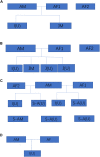The Genetic Status of the Critically Endangered Hainan Gibbon (Nomascus hainanus): A Species Moving Toward Extinction
- PMID: 33343642
- PMCID: PMC7746834
- DOI: 10.3389/fgene.2020.608633
The Genetic Status of the Critically Endangered Hainan Gibbon (Nomascus hainanus): A Species Moving Toward Extinction
Abstract
The Hainan gibbon (Nomascus hainanus), once widespread across Hainan, China, is now found only in the Bawangling National Nature Reserve. With a remaining population size of 33 individuals, it is the world's rarest primate. Habitat loss and fragmentation are the primary drivers of Hainan gibbon population decline. In this study, we integrated data based on field investigations and genotype analyses of 10 microsatellite loci (from fecal samples) to assess genetic diversity in this Critically Endangered primate species. We found that the genetic diversity of the Hainan gibbon is extremely low, with 7 of 8 microsatellite loci exhibiting decreased diversity. Additional molecular analyses are consistent with field observations indicating that individuals in groups A, B, and C are closely related, the female-male sex ratios of the offspring deviates significantly from 1:1, and the world's remaining Hainan gibbon population is expected to experience continued high levels of inbreeding in the future. Given extensive habitat loss (99.9% of its natural range has been deforested) and fragmentation, this rarest ape species faces impending extinction unless corrective measures are implemented immediately.
Keywords: Hainan gibbon; conservation; critically endangered; genetic status; population size.
Copyright © 2020 Guo, Chang, Han, Liu, Li, Garber, Xiao and Zhou.
Conflict of interest statement
The authors declare that the research was conducted in the absence of any commercial or financial relationships that could be construed as a potential conflict of interest.
Figures







Similar articles
-
Mitochondrial DNA control region sequencing of the critically endangered Hainan gibbon (Nomascus hainanus) reveals two female origins and extremely low genetic diversity.Mitochondrial DNA B Resour. 2021 Apr 7;6(4):1355-1359. doi: 10.1080/23802359.2021.1909432. Mitochondrial DNA B Resour. 2021. PMID: 33889748 Free PMC article.
-
Identifying environmental versus phylogenetic correlates of behavioural ecology in gibbons: implications for conservation management of the world's rarest ape.BMC Evol Biol. 2015 Aug 25;15:171. doi: 10.1186/s12862-015-0430-1. BMC Evol Biol. 2015. PMID: 26307405 Free PMC article.
-
How many remnant gibbon populations are left on Hainan? Testing the use of local ecological knowledge to detect cryptic threatened primates.Am J Primatol. 2017 Feb;79(2):1-13. doi: 10.1002/ajp.22593. Epub 2016 Sep 19. Am J Primatol. 2017. PMID: 27643665
-
Habitat restoration is the greatest challenge for population recovery of Hainan gibbons (Nomascus hainanus).Integr Zool. 2023 Jul;18(4):630-646. doi: 10.1111/1749-4877.12684. Epub 2022 Oct 6. Integr Zool. 2023. PMID: 36064198
-
A review on the status and modeling of suitable habitats of the southern white-cheeked gibbon.Primates. 2023 Mar;64(2):227-237. doi: 10.1007/s10329-022-01047-4. Epub 2023 Jan 6. Primates. 2023. PMID: 36607444 Review.
Cited by
-
Evidences from gut microbiome and habitat landscape indicate continued threat of extinction for the Hainan gibbon.iScience. 2024 Nov 8;27(12):111352. doi: 10.1016/j.isci.2024.111352. eCollection 2024 Dec 20. iScience. 2024. PMID: 39634557 Free PMC article.
-
Assessing the information-content of messy data to reconstruct population recovery dynamics for the world's rarest primate.Ecol Evol. 2024 Aug 7;14(8):e70089. doi: 10.1002/ece3.70089. eCollection 2024 Aug. Ecol Evol. 2024. PMID: 39114163 Free PMC article.
-
Mitochondrial DNA control region sequencing of the critically endangered Hainan gibbon (Nomascus hainanus) reveals two female origins and extremely low genetic diversity.Mitochondrial DNA B Resour. 2021 Apr 7;6(4):1355-1359. doi: 10.1080/23802359.2021.1909432. Mitochondrial DNA B Resour. 2021. PMID: 33889748 Free PMC article.
-
Science-based suggestions to save the world's rarest primate species Nomascus hainanus.Sci Adv. 2025 Apr 11;11(15):eadv4828. doi: 10.1126/sciadv.adv4828. Epub 2025 Apr 11. Sci Adv. 2025. PMID: 40215308 Free PMC article.
-
Genetic Conservation and Population Management of Non-Human Primates: Parentage Determination Using Seven Microsatellite-Based Multiplexes.Ecol Evol. 2025 Apr 7;15(4):e71216. doi: 10.1002/ece3.71216. eCollection 2025 Apr. Ecol Evol. 2025. PMID: 40196407 Free PMC article.
References
-
- Benoit G., Reeta S., Nurzhafarina O., Célia K. R., Rosdi S. M. A., Laurentius N. A., et al. (2016). Habitat fragmentation and genetic diversity in natural populations of the bornean elephant: implications for conservation. Biol. Conserv. 196 80–92. 10.1016/j.biocon.2016.02.008 - DOI
-
- Bryant J. V., Gottelli D., Zeng X., Hong X., Chan B. P., Fellowes J. R., et al. (2016a). Assessing current genetic status of the hainan gibbon using historical and demographic baselines: implications for conservation management of species of extreme rarity. Mol. Ecol. 25 3540–3556. 10.1111/mec.13716 - DOI - PubMed
LinkOut - more resources
Full Text Sources
Research Materials
Miscellaneous

